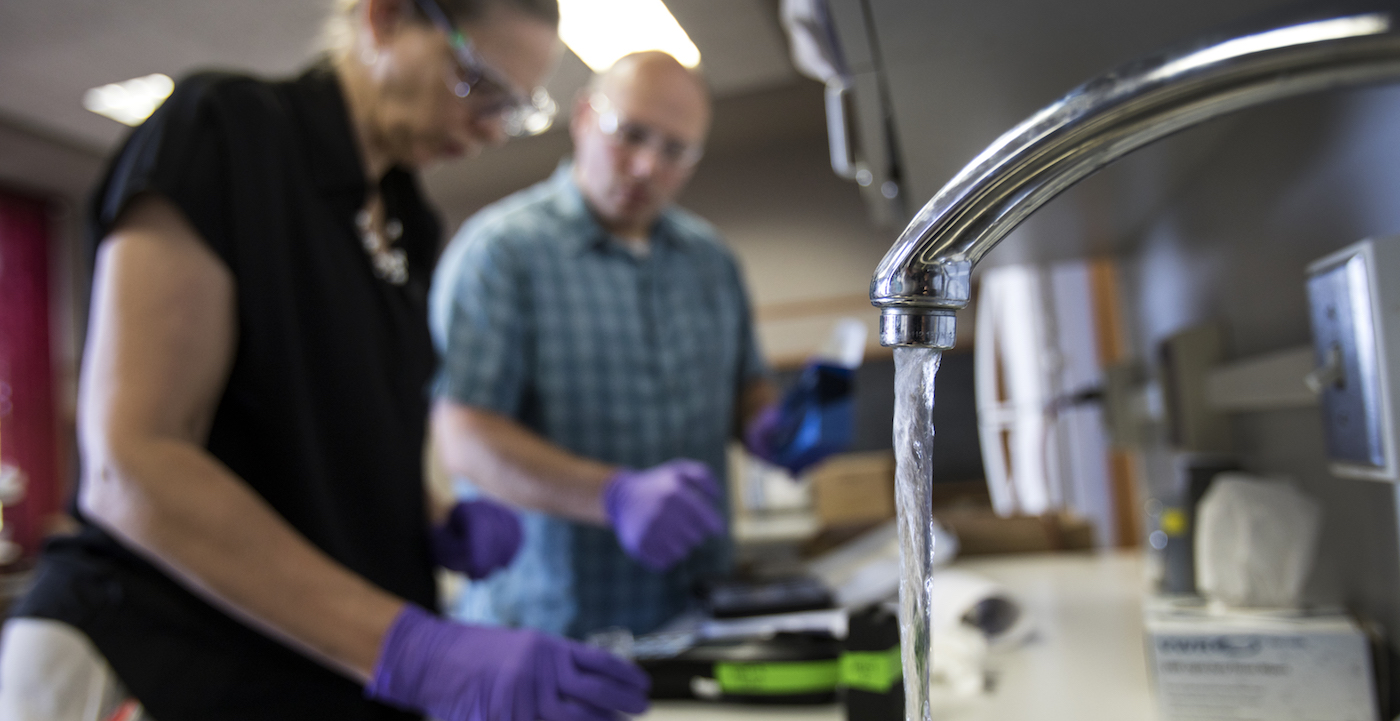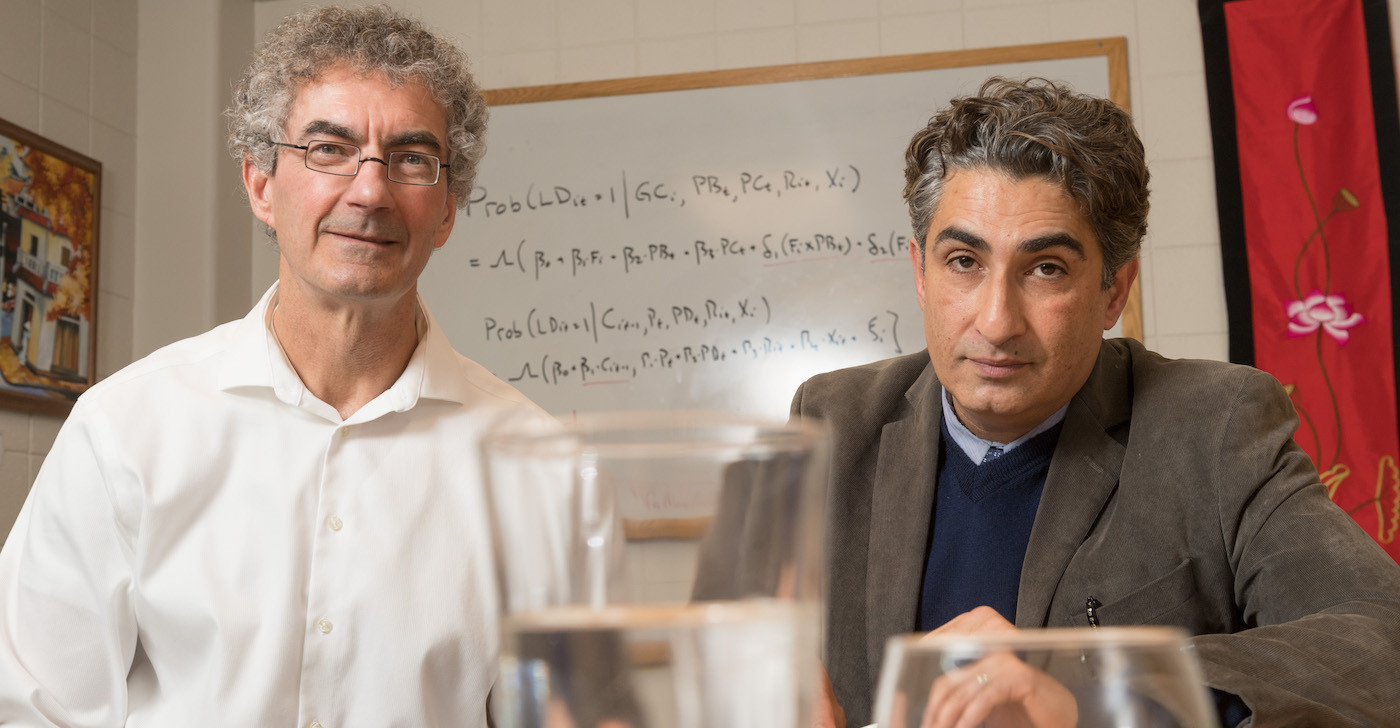
Sammy Zahran, left, discusses the findings with David Mushinski. Photo by Xavier Hadley/Colorado State University
The outbreak of Legionnaires’ disease in 2014-15 in Flint, Michigan, was likely caused by a change in the city’s drinking water supply, according to a study led by Colorado State University researchers.
Sammy Zahran, associate professor in the Department of Economics at CSU, was the lead author of an article about the study being published this week in the Proceedings of the National Academy of Science (PNAS). CSU Economics Professor David Mushinski was a co-author.

Based on a detailed statistical analysis of multiple datasets by Zahran and his co-authors, the Flint Area Community Health and Environment Partnership (FACHEP) found that the majority of Legionnaires’ disease cases that occurred during the 2014-15 outbreak in Genesee County, Michigan, can be attributed to a change in the City of Flint’s drinking water supply, from Lake Huron to the Flint River.
A comprehensive study
The researchers conducted an exhaustive analysis of data on Legionnaires’ cases in Genesee, Wayne and Oakland counties between 2011 and 2016. FACHEP researchers determined that in 2014-15 an increase in the risk of acquiring Legionnaires’ disease across the Flint water distribution system was consistent with a systemwide proliferation of Legionella bacteria.
The researchers determined that an estimated 80 percent of Legionnaires’ cases during this period were attributable to the change in water supply, according to the article in PNAS.
“During the period when their water was supplied from the Flint River, Flint residents were seven times more likely to develop Legionnaires’ disease,” Zahran said. “After public announcements urging residents to boil their water, there was a lower risk of developing the disease, likely because people avoided using their water.”

Photo by Evan Dougherty/University of Michigan
Data indicate that the Legionnaires’ outbreak at a local hospital alone could not account for the increase in Legionnaires’ disease cases that occurred in Flint during the water crisis.
“Our study shows that during the water crisis, the risk of a Flint resident having Legionnaires’ disease increased as the amount of free chlorine in their water decreased,” said Shawn McElmurry, associate professor of civil and environmental engineering at Wayne State University and the FACHEP principal investigator. “Since municipalities typically evaluate the risk of waterborne illnesses by measuring free chlorine, a better understanding of how chlorine is deactivated can inform future water management policies and practices.” Chlorine is routinely added to drinking water to kill microbes.
Effect outside Flint
During the water crisis, the likelihood of Legionnaires’ disease occurring in communities adjacent to Flint also increased, probably due to the number of people who commuted into Flint.
After the city returned to the Lake Huron water source supplied by the Great Lakes Water Authority, the risk of a Flint neighborhood presenting with Legionnaires’ disease retreated to historically normal levels.

Photo by Evan Dougherty/University of Michigan
McElmurry noted that the investigation was challenging. “These are very complicated questions, and we are working with a very talented team of investigators including epidemiologists, infectious disease specialists, microbiologists, water engineers, social-behavioral scientists and statisticians to understand what happened in Flint,” he said. “Most important was the assistance of residents who worked directly with us on this challenging problem.”
Peer review
The peer-review process for research published in academic journals helps verify that the methods and conclusions have been evaluated by experts in the field and meets rigorous standards for accuracy. Research and the peer review process take time.
“While we have been anxious to share these results as soon as possible, we thought it was also important that our research was subjected to the highest level of independent review,” said McElmurry. “Peer review allows us to demonstrate that our work is independent and free of any external influence.”

Photo by Marcin Szczepanski/University of Michigan
FACHEP is a consortium led by Wayne State University that includes the University of Michigan, Michigan State University, Kettering University, Colorado State University and the Henry Ford Health System.
The FACHEP team conducted multidisciplinary research in Flint through funding from the Michigan Department of Health and Human Services, the National Science Foundation, the National Institutes of Health, Wayne State University, the University of Michigan and Michigan State University.
Additional information about Legionnaires’ disease can be found at the Genesee County Health Department website, the Michigan Department of Health and Human Services website, and the Centers for Disease Control and Prevention website.

Mushinski, left, and Zahran. Photo by John Eisele/Colorado State University